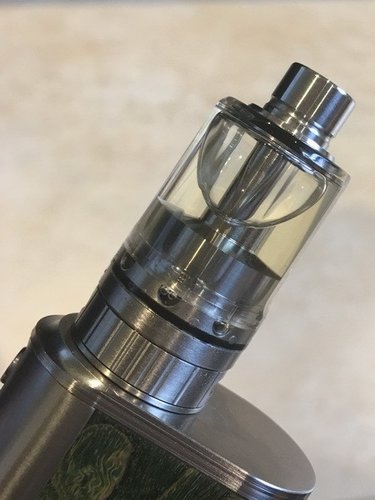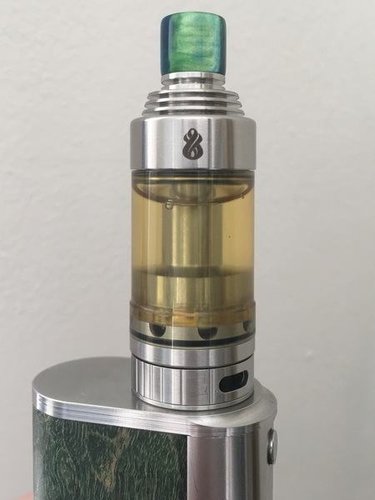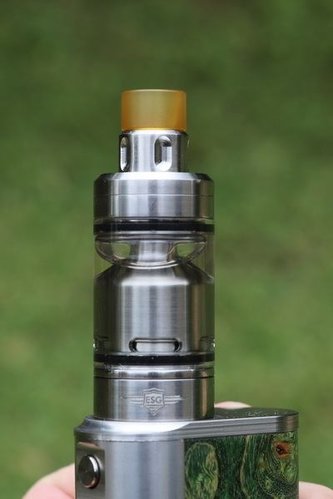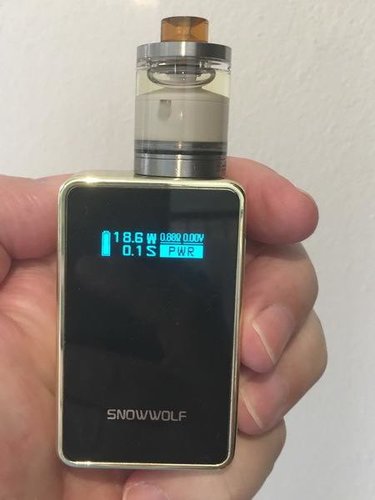There has been a lot of talk around justification of High-End (HE) atomizers. While the comments and feedback that I have seen have been constructive a lot of them are inaccurate and based on a lot of speculation. While I do believe that so long as the atomizer satisfies a Vapers needs, surely the question that needs to be asked is "Can it get any better?"
The answer is YES!
While I do agree with most that some of the prices are rather high and a lot of money to dish out for some stainless steel, insulation and what not, one needs to look at the whole concept a bit closer. In this part of my deep dive into HE I am going to be looking at RDAs first as this is probably the most basic concept and easiest to understand.
So with any dripper I would expect the following:
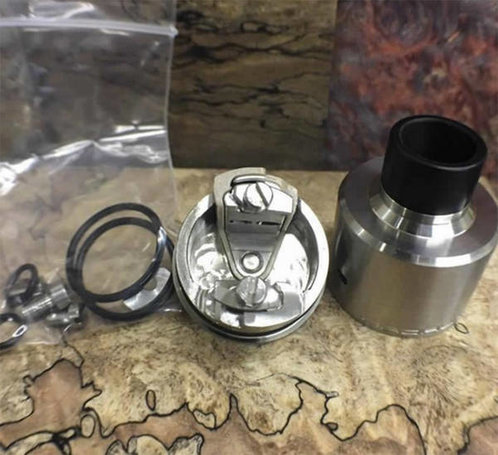
So the basic principle is that I will insert my coil between the two posts and from there by passing current through the atomizer I have a resistance in the coil that energy builds up and by physics (Newtons Laws) I have a release of energy. Simple enough!
So now if I take a step back, surely an RDA that costs R500 compared to R1500 should not be that much different other than the "style" of vaping I have? This can also be said that surely a clone is just as good as an authentic RDA right? This in fact is completely wrong.
Firstly lets put to bed the whole clone story. A clone yes can be a replica in look of an RDA however one needs to consider the following facts. The chances of the clone being of the same metallurgical composition and properties is out the window. This means that the design of the RDA that factors things like HEAT TRANSFER are completely set out of balance. Why this is important you ask? Well it is very simple. Although the irony is that we heat a coil to produce vaper, the actual cap and deck heating to a high temperature has an impact on the vaper production, quality of flavor and efficiency and demand I have on my mod - SO heat on my DECK is a NO,NO. The materials used in HE RDAs are used to keep the unit as cool as possible and to also dissipate heat as quickly as possible. This is the first thing that is factored when an RDA is made. You would be shocked how many HE modders claim a "majority" stainless steel 316L base but in fact have added "unnamed" additional materials into the composition to enhance heat transfer physics. I bet that has got your mind thinking already?
That is one of the many reasons clones are plain and simply crap! Should there be a need for me to go into more detail about this - I will do so if asked.
Right!
Let us now look at a normal commercial RDA vs that of a HE RDA.
The first thing I need to tell you is that the price does not always determine if an atomizer is HE or not. Let us look at the DotMod Petri v1.2 that costs R1500 vs the Psyclone Hadaly RDA that costs R1100. The Petri is not considered HE while the Hadaly is. Why is this you may ask? Let us jump into it.
Airflow, Airflow, Airflow!
So one of the things that is found in HE RDAs is airflow, airflow, airflow. Why is this important? Well the most basic way to explain it is as follows, the more air to vaper production I have the more cloud I produce at the compromise of flavor. The more vaper to air production I have the less cloud I have but the more flavor I produce. If you can understand this simple ideology you will then understand why flavor RDAs are 22mm in size and cloud RDAs are 24mm+.
The next thing I need to consider is that the cooler I can keep my coils the more flavor I can produce. Why is this? Well it is because when my coil overheats the juices molecular structure begins to breakdown at a rate that a) the concentrates within the juice breakdown and vaporize incorrectly b) VG beings to separate from PG causing inconsistent vaper production. Need proof? Get yourself a chocolate flavored juice - Mr Hardwicks Chocolate whip (fantastic juice BTW). Vape it at a low wattage vs a high wattage. You will notice that at a high wattage the chocolate flavor is not as great as at a low wattage. This is not because the juice has an issue what so ever. It is because the chocolate concentrate is very sensitive to heat! I am sure a lot of juice makers will even tell you that when mixing their juice at a temperature that certain concentrates cannot be added until the juice is cooler. The same principle applies when vaporizing your juice within your RDA.
How I direct the airflow onto my coils is also important, this is where HE shines. Most of the modders that design and engineer their RDAs spend MONTHS testing their designs and making sure that the airflow is hitting the coil correctly. Lets look at the Hadaly for example:
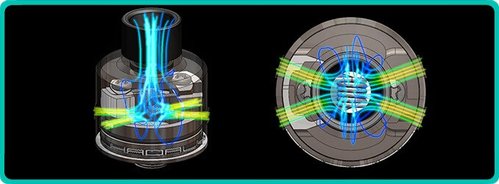
Mac is a very good friend and actually took his RDA to a fluid dynamics engineer to get the physics of how the airflow would hit his coil. The flow above shows exactly what makes this RDA HE. The other thing you will notice is the laminar flow of the air (this is basically how much turbulence or lack there of I have with the airflow transferring onto the coil and out through the mouthpiece.
You will probably not be surprised then to know that most commercial RDAs take their designs from the HE designs and try to achieve the same result (even though not possible) as the HE RDAs. The question you then ask is why are they not similar? Well this comes down to the fact that these RDAs require very special CNC machines to get the correct angles and dimensions where commercial RDAs are mass produced and cannot have a single piece sitting on a CNC for 30min. HE is all about perfection and getting the most out of a coil.
The next thing we need to look at is the conductivity of electrical current from our mod into the RDA from the flow of electrical direction being positive to negative. The metallurgical properties of how the conductivity impacts the voltage drop the RDA itself has on the overall circuit. The less drop I have the more responsive my RDA will be. It is not just about what type of coil you build and material you have (even though yes it does play a part in the bigger picture).
We also need to look at how I hold our coils in place, that design is always unique within the HE space, why you may ask? Well where vaping has evolved to, modders need to take into consideration all types of coils but also at the same same minimize resistance fluctuations. Remember where I spoke about heat transfer, well lets look at that a bit further, remember we have said that heat is BAD! Well if you look at physics 101, the hotter something gets the more my base resistance will increase.
The cap of your RDA when it comes to HE. You might see that some RDAs have fins on them, I promise you this is not only to make the cap look cool but to help the heat dissipation factors. Further to that the design of a cap is there to make the airflow as laminar as possible so that when I inhale vapor I am getting as much vapor off the coils as possible. In addition to this most flavor designs are there to get our mouths as close as possible to the coil so that we can extract as much flavor as possible.
There is a lot more I could go into but I think that is enough food for though for now... I hope it helps show how much goes into an HE RDA and how commercial RDAs are influenced.
End of Part 2...
The answer is YES!
While I do agree with most that some of the prices are rather high and a lot of money to dish out for some stainless steel, insulation and what not, one needs to look at the whole concept a bit closer. In this part of my deep dive into HE I am going to be looking at RDAs first as this is probably the most basic concept and easiest to understand.
So with any dripper I would expect the following:
- A typical RDA
- The Deck
- A positive and negative post - Sometimes a 2 post, 3 post or 4 post.
- Some form of being able to hold my coil down i.e. grubs or clamps
- Insulation material to separate the conductivity between my positive and negative posts.
- Airflow to channel my air to my coils on some decks, some do not have this as they rely on the cap to do this for us.
- The Cap
- The Drip Tip or Chuff - sometimes the Cap and DripTip are integrated into one.
- 510 pin
- The Deck

So the basic principle is that I will insert my coil between the two posts and from there by passing current through the atomizer I have a resistance in the coil that energy builds up and by physics (Newtons Laws) I have a release of energy. Simple enough!
So now if I take a step back, surely an RDA that costs R500 compared to R1500 should not be that much different other than the "style" of vaping I have? This can also be said that surely a clone is just as good as an authentic RDA right? This in fact is completely wrong.
Firstly lets put to bed the whole clone story. A clone yes can be a replica in look of an RDA however one needs to consider the following facts. The chances of the clone being of the same metallurgical composition and properties is out the window. This means that the design of the RDA that factors things like HEAT TRANSFER are completely set out of balance. Why this is important you ask? Well it is very simple. Although the irony is that we heat a coil to produce vaper, the actual cap and deck heating to a high temperature has an impact on the vaper production, quality of flavor and efficiency and demand I have on my mod - SO heat on my DECK is a NO,NO. The materials used in HE RDAs are used to keep the unit as cool as possible and to also dissipate heat as quickly as possible. This is the first thing that is factored when an RDA is made. You would be shocked how many HE modders claim a "majority" stainless steel 316L base but in fact have added "unnamed" additional materials into the composition to enhance heat transfer physics. I bet that has got your mind thinking already?
That is one of the many reasons clones are plain and simply crap! Should there be a need for me to go into more detail about this - I will do so if asked.
Right!
Let us now look at a normal commercial RDA vs that of a HE RDA.
The first thing I need to tell you is that the price does not always determine if an atomizer is HE or not. Let us look at the DotMod Petri v1.2 that costs R1500 vs the Psyclone Hadaly RDA that costs R1100. The Petri is not considered HE while the Hadaly is. Why is this you may ask? Let us jump into it.
Airflow, Airflow, Airflow!
So one of the things that is found in HE RDAs is airflow, airflow, airflow. Why is this important? Well the most basic way to explain it is as follows, the more air to vaper production I have the more cloud I produce at the compromise of flavor. The more vaper to air production I have the less cloud I have but the more flavor I produce. If you can understand this simple ideology you will then understand why flavor RDAs are 22mm in size and cloud RDAs are 24mm+.
The next thing I need to consider is that the cooler I can keep my coils the more flavor I can produce. Why is this? Well it is because when my coil overheats the juices molecular structure begins to breakdown at a rate that a) the concentrates within the juice breakdown and vaporize incorrectly b) VG beings to separate from PG causing inconsistent vaper production. Need proof? Get yourself a chocolate flavored juice - Mr Hardwicks Chocolate whip (fantastic juice BTW). Vape it at a low wattage vs a high wattage. You will notice that at a high wattage the chocolate flavor is not as great as at a low wattage. This is not because the juice has an issue what so ever. It is because the chocolate concentrate is very sensitive to heat! I am sure a lot of juice makers will even tell you that when mixing their juice at a temperature that certain concentrates cannot be added until the juice is cooler. The same principle applies when vaporizing your juice within your RDA.
How I direct the airflow onto my coils is also important, this is where HE shines. Most of the modders that design and engineer their RDAs spend MONTHS testing their designs and making sure that the airflow is hitting the coil correctly. Lets look at the Hadaly for example:

Mac is a very good friend and actually took his RDA to a fluid dynamics engineer to get the physics of how the airflow would hit his coil. The flow above shows exactly what makes this RDA HE. The other thing you will notice is the laminar flow of the air (this is basically how much turbulence or lack there of I have with the airflow transferring onto the coil and out through the mouthpiece.
You will probably not be surprised then to know that most commercial RDAs take their designs from the HE designs and try to achieve the same result (even though not possible) as the HE RDAs. The question you then ask is why are they not similar? Well this comes down to the fact that these RDAs require very special CNC machines to get the correct angles and dimensions where commercial RDAs are mass produced and cannot have a single piece sitting on a CNC for 30min. HE is all about perfection and getting the most out of a coil.
The next thing we need to look at is the conductivity of electrical current from our mod into the RDA from the flow of electrical direction being positive to negative. The metallurgical properties of how the conductivity impacts the voltage drop the RDA itself has on the overall circuit. The less drop I have the more responsive my RDA will be. It is not just about what type of coil you build and material you have (even though yes it does play a part in the bigger picture).
We also need to look at how I hold our coils in place, that design is always unique within the HE space, why you may ask? Well where vaping has evolved to, modders need to take into consideration all types of coils but also at the same same minimize resistance fluctuations. Remember where I spoke about heat transfer, well lets look at that a bit further, remember we have said that heat is BAD! Well if you look at physics 101, the hotter something gets the more my base resistance will increase.
The cap of your RDA when it comes to HE. You might see that some RDAs have fins on them, I promise you this is not only to make the cap look cool but to help the heat dissipation factors. Further to that the design of a cap is there to make the airflow as laminar as possible so that when I inhale vapor I am getting as much vapor off the coils as possible. In addition to this most flavor designs are there to get our mouths as close as possible to the coil so that we can extract as much flavor as possible.
There is a lot more I could go into but I think that is enough food for though for now... I hope it helps show how much goes into an HE RDA and how commercial RDAs are influenced.
End of Part 2...
Last edited:



